WIT Life #366: 読書の秋
Interpreter/Translator/Writer Stacy Smith (Kumamoto-ken CIR, 2000-03) presents WIT Life, a periodic series about aspects of Japanese culture such as art, film, food and language. Stacy starts her day by watching Fujisankei’s newscast in Japanese, and here she offers some interesting tidbits and trends along with her own observations.
Time flies and hard to believe that we are already at the beginning of fall. For all of you bookworms like myself, as the title says this season is often called 読書の秋 (dokusho no aki or “autumn is for reading)”. Alternatively, for those who love pumpkin spice and everything nice, it is also known as 食欲の秋 (shokuyoku no aki or “season of good appetite”/”fall is for eating”). Other versions include 実りの秋 (minori no aki or “the harvest season”), 芸術の秋 (geijutsu no aki or “best season for enjoying art”), and スポーツの秋 (supo-tsu no aki or “best season for sports”).
Japan had its state funeral for former PM Shinzo Abe this week, with many waiting to offer their condolences and many others offering vociferous protest. His assassination has revealed the deep connections between the Liberal Democratic Party and the Unification Church, the repercussions of which are yet to be seen. This NYT article from earlier in the month touches on the relationship between the LDP and the church, in the context of Japan’s thriving telegram industry. For a heart-warming read, check out this other NYT article which talks about “baby workers” in Japan’s nursing homes.
On a personal note, I recently interpreted at a Japanese food event called “Taste of Japan in New York” that was held at Carnegie Hall. Many famous chefs attended from Japan, sharing their knowledge and creating one-of-a-kind menus focused on the country’s rich fermentation culture. PM Fumio Kishida was in town for the UN General Assembly and appeared at the end as a surprise guest! In his remarks, he highlighted how next month Japan will loosen its Covid restrictions and once again welcome individual tourists. I’ve tried to get back to Japan twice during the pandemic, so I’m hoping three times is a charm for my visit scheduled for next year!
WIT Life #365: New York Asian Film Festival
Interpreter/Translator/Writer Stacy Smith (Kumamoto-ken CIR, 2000-03) presents WIT Life, a periodic series about aspects of Japanese culture such as art, film, food and language. Stacy starts her day by watching Fujisankei’s newscast in Japanese, and here she offers some interesting tidbits and trends along with her own observations.
The New York Asian Film Festival taking place at Lincoln Center is one of my favorite annual events, and it’s coming to a close this weekend. This year the festival celebrated its 20th anniversary, and it was back in person for the first time in two years. Over the first week, I was lucky enough to interpret for several actors, producers and directors. Particularly thrilling was being able to work with the actor Hiroshi Abe, of whom I’ve been a longtime fan. He attended the festival to receive the 2022 Screen International Star Asia Award and participate in the Q&A for his film Offbeat Cops, which had its world premiere at the festival.
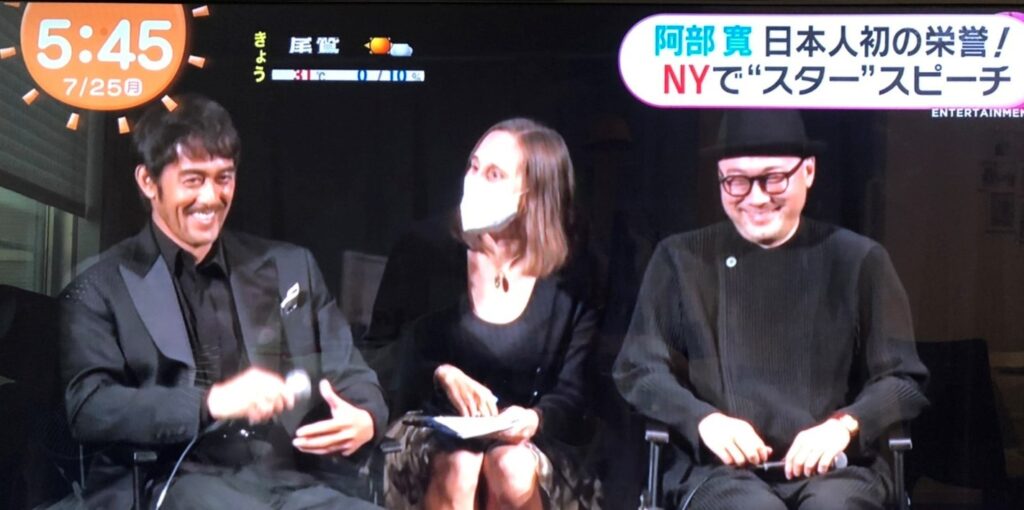
My sharp-eyed friend in Japan was up early watching Fuji’s Mezamashi TV, and she was able to capture this photo of me on stage with Abe and Offbeat Cops director Eiji Uchida (to my left/right respectively in the picture). Abe plays a hard-boiled detective named Naruse who gets shunted off to the police band, and ends up going on a journey of self-discovery as a result (and learns how to play the drums, as the actor had to in real life!). During the Q&A, Uchida expressed his desire to make a sequel where Naruse has a showdown with the NYPD Police band, and to the delight of the crowd Abe said that he’s be up for it.
Read MoreWIT Life #364: What’s in a Name?
Interpreter/Translator/Writer Stacy Smith (Kumamoto-ken CIR, 2000-03) presents WIT Life, a periodic series about aspects of Japanese culture such as art, film, food and language. Stacy starts her day by watching Fujisankei’s newscast in Japanese, and here she offers some interesting tidbits and trends along with her own observations.
It’s been a while since I’ve written here, and it’s nice to be back. I hope that everyone’s early summers are going well! An interesting announcement was made in Tokyo this week in regard to the terminology for “childcare leave.” Previously 育休 (ikukyu) was the term used , but it was officially changed to the phrase 育業 (ikugyo). You can see that the first character, referring to “raising children” has stayed the same, but the second character for “time off” or “rest” has been changed to the one for “work.”

According to Tokyo Governor Yuriko Koike, this new terminology is more appropriate because “child-rearing is the important, valuable work of raising those who will carry our future.” Gyo indicates results achieved by putting in effort, whereas kyu is associated more with taking a break and doesn’t acknowledge the hard work involved. In a public appeal citizens were asked to come up with a new catchphrase for childcare leave, and this one was selected from almost 9000 submissions received in just a month.
Read MoreWIT Life #363: Golden Week greetings
Interpreter/Translator/Writer Stacy Smith (Kumamoto-ken CIR, 2000-03) presents WIT Life, a periodic series about aspects of Japanese culture such as art, film, food and language. Stacy starts her day by watching Fujisankei’s newscast in Japanese, and here she offers some interesting tidbits and trends along with her own observations.
Happy Golden Week 2022! Things kicked off yesterday with 昭和の日 (Showa no Hi, commemorating Showa Era emperor Hirohito’s birthday) and continue all the way through next week with 憲法記念日 (Kenpou Kinenbi or Constitution Memorial Day), みどりの日 (Midori no Hi or Greenery Day), and こどもの日 (Kodomo no Hi or Children’s Day, which actually celebrates boys with the flying carp streamers pictured below. Girls have their own holiday on March 3 for 雛祭り, or Hinamatsuri). I have many clients in town for Golden Week, so it’s nice to see that business travel from Japan has resumed.
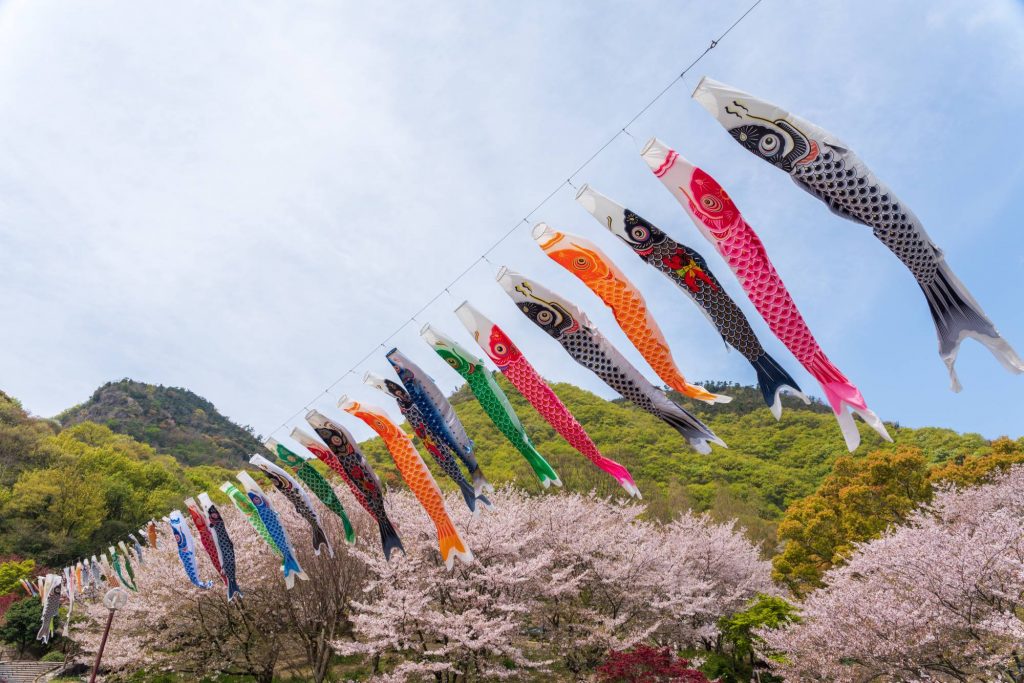
WIT Life #362: Drive My Car gets its Oscar!
Interpreter/Translator/Writer Stacy Smith (Kumamoto-ken CIR, 2000-03) presents WIT Life, a periodic series about aspects of Japanese culture such as art, film, food and language. Stacy starts her day by watching Fujisankei’s newscast in Japanese, and here she offers some interesting tidbits and trends along with her own observations.
The Oscars this past weekend were memorable in more ways than one, but I’d like to focus on Drive My Car winning Best International Feature Film! As I mentioned in my previous post, DMC is the second Japanese film to receive this honor since Departures (おくりびと or Okuribito) in 2008. I was proud of director Ryusuke Hamaguchi for giving his acceptance speech in English, though I wish they hadn’t tried to play him off the stage twice (his finger raised to ask for more time was golden).

WIT Life #361: Making Oscar History with Drive My Car
Interpreter/Translator/Writer Stacy Smith (Kumamoto-ken CIR, 2000-03) presents WIT Life, a periodic series about aspects of Japanese culture such as art, film, food and language. Stacy starts her day by watching Fujisankei’s newscast in Japanese, and here she offers some interesting tidbits and trends along with her own observations.
I enjoyed watching the SAG Awards last night and it got me excited for the Oscars, which will take place in exactly one month. Drive My Car is the first Japanese film ever to be nominated for Best Picture in the ceremony’s 94-year history! In addition, Ryusuke Hamaguchi picked up a Directing nomination, as well as one for Adapted Screenplay with his co-writer Takamasa Oe. The film’s fourth nomination in the category of International Feature Film is the one it has the best odds of winning. If the many awards Drive My Car has already picked up at Cannes and other major film festivals are any indication, Hamaguchi and his team will be going home with at least one gold statue.

WIT Life #360: 今年の漢字
Interpreter/Translator/Writer Stacy Smith (Kumamoto-ken CIR, 2000-03) presents WIT Life, a periodic series about aspects of Japanese culture such as art, film, food and language. Stacy starts her day by watching Fujisankei’s newscast in Japanese, and here she offers some interesting tidbits and trends along with her own observations.
As 2021 draws to a close, everyone is likely experiencing a variety of emotions in regard to the beginning of a new year. An article in the Washington Post surveyed more than 200 readers on the one word they would use to describe the past year. Their answers were as follows: “Relentless. Disappointing. Messy. Clarifying. Growth. Grief. Change. Survival. Fragile. Unexpected. Enlightening. Tumultuous. Transformational. Lonely.”
Japan takes a similar pulse of its nation with the annual determining of the “Kanji of the Year.” The single character selected is supposed to represent how the populace views the closing year, and for 2021 it was deemed to be 金 (kin, or money/gold). The winner beat out 輪 (rin, or circle/wheel) by only 118 votes.
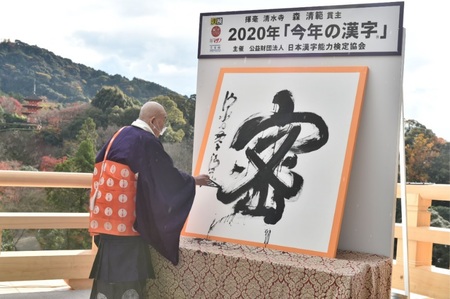
According to the Japan Kanji Aptitude Testing Association that administers the voting, kin was a fitting choice because the Tokyo summer Olympics were the venue for the Japanese Olympic team’s best results ever (including 27 gold medals). The association also noted that kin begins the word 金字塔 (kinjito, or monumental achievement), pointing to the success of MLB’s American League MVP Shohei Ohtani as well as professional shogi player Sota Fujii, who became the youngest four-crown titleholder in the game’s history.
Read MoreWIT Life #359: Giving thanks
Interpreter/Translator/Writer Stacy Smith (Kumamoto-ken CIR, 2000-03) presents WIT Life, a periodic series about aspects of Japanese culture such as art, film, food and language. Stacy starts her day by watching Fujisankei’s newscast in Japanese, and here she offers some interesting tidbits and trends along with her own observations.
I hope everyone is enjoying a wonderful holiday weekend, and that your Thanksgiving was filled with lots of food, fun and family/friends! This is the season of expressing gratitude, and I can’t help but be thankful for this venue where I can share my thoughts. Specifically, I’m grateful that I began my Japanophile journey in high school and that it’s taken me this far.
My work as an interpreter is slowly starting to rebound, and I am deeply appreciative for that. I was tickled to find that there is an interpreter out there who recently received official recognition for his skills, that being none other than the Angels’ two-way superstar Shohei Ohtani’s interpreter Ippei Mizuhara.

Following Ohtani being deemed the American League’s Most Valuable Player (MVP) this year, Mizuhara received a Most Valuable Interpreter (MVI) award from the Angels. On Twitter, fans wholeheartedly agreed with the team’s sentiment: “The existence of Ippei is indispensable not only for Shohei, but for all of us.”
Read MoreWIT Life #358: LA eats Japan
Interpreter/Translator/Writer Stacy Smith (Kumamoto-ken CIR, 2000-03) presents WIT Life, a periodic series about aspects of Japanese culture such as art, film, food and language. Stacy starts her day by watching Fujisankei’s newscast in Japanese, and here she offers some interesting tidbits and trends along with her own observations.
Although the days are still balmy here in NY, we’ve had some chilly nights and mornings as we get deeper into fall. In LA however, the warm weather sticks around longer, allowing for fun outdoor activities as we move closer to winter. I’d like to share one that I wish I was able to attend in person!
LA eats Japan has been an annual food festival since 1999, and it will be held outdoors for the first time this year at Little Tokyo. This free event will be held on Sunday, November 14 from 11 am-8 pm, and is presented by the Japanese Restaurant Association of America with support from the Consulate General of Japan in LA.

There will be 17 vendors from local restaurants selling curry rice, yakitori, okonomiyaki, ramen, yakisoba and sushi, as well as sweets such as kakigori and castella. In addition to all this amazing food, there will be a cosplay costume competition with a prize of $1,000. Live performances will feature contemporary techno music, as well as traditional martial arts and music like karate and taiko. A mikoshi portable shrine will even be paraded through the streets!
For those who want to experience Japanese food, culture and sightseeing spots but aren’t able to travel at this time, I would like to recommend the Kyushu Virtual Fest to be held Thursday night. It is the second half of a two-part event, and I attended the first last night. Having lived in Kumamoto on JET, I was thrilled that they spotlighted Aso and other amazing places in the prefecture, as well as a waterfall I had never visited but hope to on my next trip. They also highlighted sites and products from Fukuoka and Kagoshima, and there were many giveaways and discounts for viewers. This event is free as well so definitely check it out!
WIT Life #357: LDP Presidential election and royal family shakeup
Interpreter/Translator/Writer Stacy Smith (Kumamoto-ken CIR, 2000-03) presents WIT Life, a periodic series about aspects of Japanese culture such as art, film, food and language. Stacy starts her day by watching Fujisankei’s newscast in Japanese, and here she offers some interesting tidbits and trends along with her own observations.
The Japanese LDP Presidential election will take place today (September 29th). The winner is expected to become the next prime minister following current PM Yoshihide Suga, leading the party in November’s general election. Here’s a run-down of the candidates, notable for being a lineup that is 50% women.

In other big news, Princess Mako of the royal family just welcomed home her fiancee, commoner Kei Komuro. When he was last in Japan over three years ago, he got engaged to Mako before coming to New York to attend Fordham Law School. They plan to marry and for Mako to return with him to New York, where he has been hired by a law firm. In renouncing her official title, she will be sacrificing almost $1.35 million in taxpayer money. Check out the Washington Post’s coverage of the palace intrigue captivating Japan (and the vitriol towards Komuro’s Covid ponytail)!
WIT Life #356: Tokyo 2020 Paralympic Games
Interpreter/Translator/Writer Stacy Smith (Kumamoto-ken CIR, 2000-03) presents WIT Life, a periodic series about aspects of Japanese culture such as art, film, food and language. Stacy starts her day by watching Fujisankei’s newscast in Japanese, and here she offers some interesting tidbits and trends along with her own observations.
Thanks to all the recent rain it seems as if the summer heat has broken a bit, but I can’t wait for fall to arrive, along with its cooler temps and 紅葉 (kouyou, or leaves changing color). Though I must say I’m not quite ready for the ubiquitous pumpkin spice marketing that has already started!

The Tokyo 2020 Paralympic Games began on August 24, and they feature over 4000 athletes from 162 National Paralympic Committees worldwide. You can find a recap of the Opening Ceremony here, and daily schedules/results here. The Games will run through September 5, so happy viewing!
WIT Life #355: Tokyo 2020 Olympics
Interpreter/Translator/Writer Stacy Smith (Kumamoto-ken CIR, 2000-03) presents WIT Life, a periodic series about aspects of Japanese culture such as art, film, food and language. Stacy starts her day by watching Fujisankei’s newscast in Japanese, and here she offers some interesting tidbits and trends along with her own observations.
A quick mid-summer hello to all and hope those Olympic fans out there are enjoying the games. In lieu of a longer post, I’m going to leave you with some related articles from the Washington Post that I think are worth sharing.
First, an analysis of why holding the Olympics was so important to Japan this year, as well as its historic role in the country’s post-war development.
Congrats to Japanese-American Olympian Erica Sullivan for getting the silver in the women’s 1,500-meter freestyle! As this article details, she wowed the crowd with the native Japanese that she learned from her mother.
Finally, this article discusses the complicated feelings Fukushima residents have toward the Olympics. Many feel the exorbitant amount of money used would be better spent on the Tohoku region’s continued reconstruction, and that the “recovery” being touted by Olympic organizers is nothing more than a PR ploy.
Happy viewing!
WIT Life #354: 969 NYC Coffee
Interpreter/Translator/Writer Stacy Smith (Kumamoto-ken CIR, 2000-03) presents WIT Life, a periodic series about aspects of Japanese culture such as art, film, food and language. Stacy starts her day by watching Fujisankei’s newscast in Japanese, and here she offers some interesting tidbits and trends along with her own observations.
Japan’s COVID-19 situation continues to worsen, and the state of emergency declaration for Tokyo, Osaka and eight other prefectures has been extended through mid-June. Okinawa in particular has shown high case numbers as of late. And yet the Olympics are still scheduled to proceed without a hitch?…Meanwhile, here in the U.S. we are slowly coming out of our quarantine slumber and rejoining the real world. Last weekend’s warm temperatures allowed my partner and I to discover a great Japanese cafe during a walk.
This spot is 969 NYC Coffee, opened by owner/chef Mitsumine Oda in 2016. He worked in the past for a Tokyo company, but he hated being a salaryman under someone else’s direction. Sick of long hours and in search of independence, he decided to quit and strike out on his own in the U.S. Oda first worked at a sushi cafe in Manhattan for three years, where he earned enough money to buy a house for himself and his sister and mother, who had also immigrated and became citizens.
969 NYC Coffee’s menu features a variety of onigiri, ramen, sushi and other Japanese food faves. Don’t be fooled by the name, as it also has an extensive menu of non-coffee drinks, especially matcha options. We got a smattering of delicious dishes, starting with onigirazu, a sandwich with rice instead of bread and wrapped in seaweed (I tried this for the first time and found it to be very filling!). We enjoyed the two types of Hiroshima fried oyster (カキ or kaki), adorned with avocado and a slice of American cheese, and fried mackerel (アジ or aji), also with avocado as well as a spicy mayo sauce. Rounding out our meal were seaweed salads and luxurious coconut milk matcha lattes (made with matcha from Japan, Oda noted.)
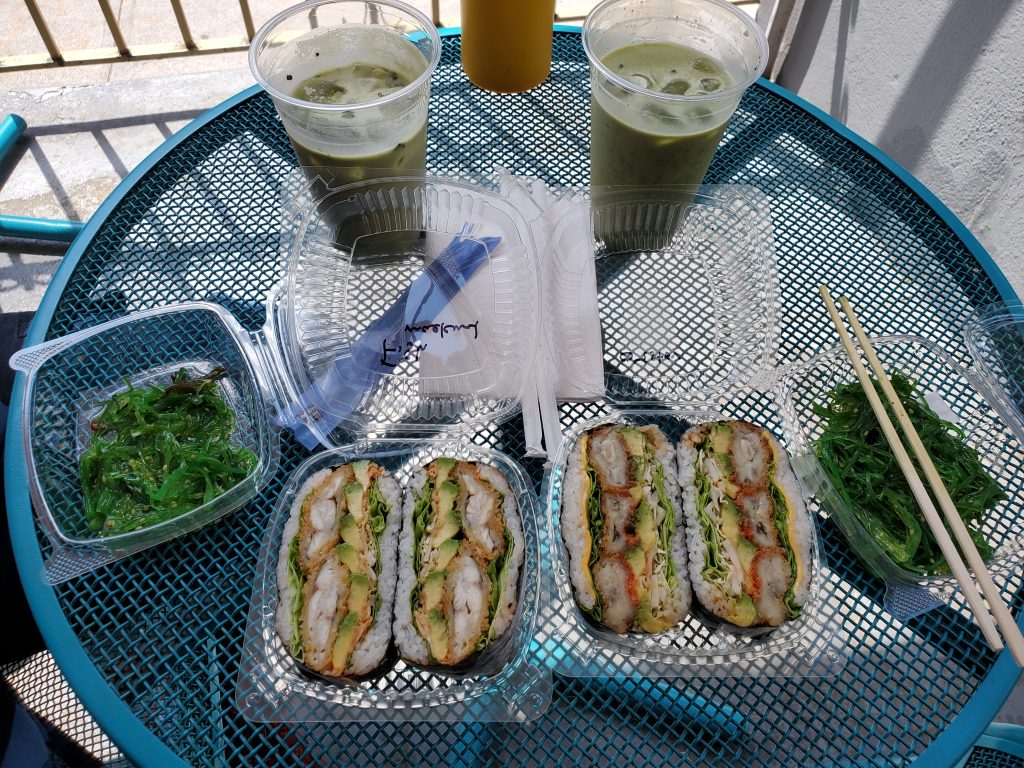
WIT Life #353: Covid vax in Japan
Interpreter/Translator/Writer Stacy Smith (Kumamoto-ken CIR, 2000-03) presents WIT Life, a periodic series about aspects of Japanese culture such as art, film, food and language. Stacy starts her day by watching Fujisankei’s newscast in Japanese, and here she offers some interesting tidbits and trends along with her own observations.
During President Biden’s speech to Congress last night, he celebrated the milestone of having successfully delivered 200 million COVID-19 vaccines within his first 100 days. About 42.3% of our population has been vaccinated, compared with Israel and England who have vaccinated 62.3% and 50% of their populations respectively. Japan, on the other hand, has only gotten to about 1.8% of its population. Here anyone over 16 can now receive the vaccine, but in Japan they are still concentrating on getting vaccines to frontline healthcare workers and the general public age 65 or older.
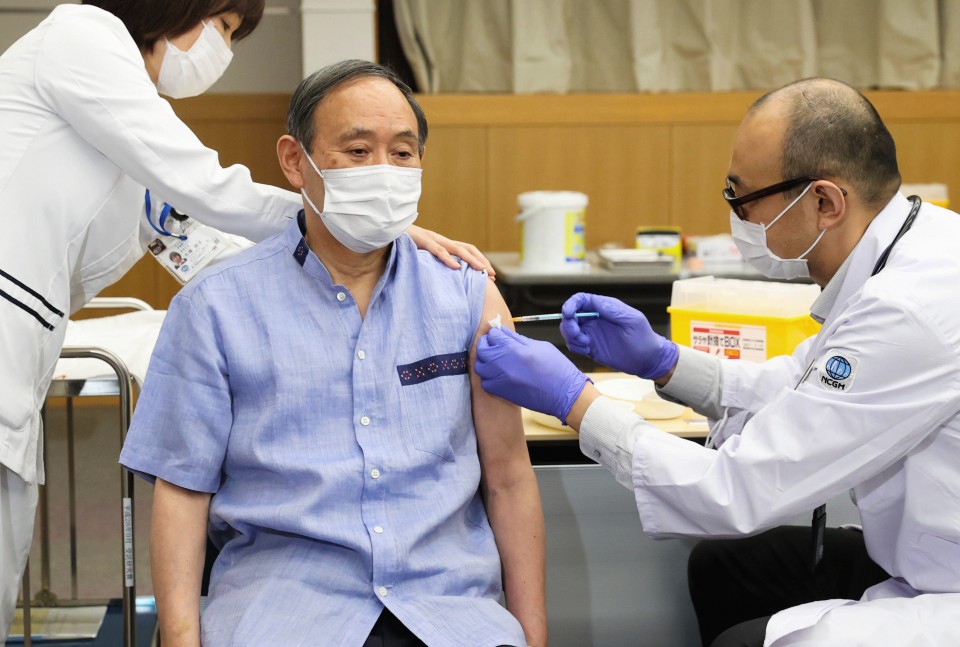
However, Japan is having a few logistical hiccups similar to our early bumpy rollout. Some elderly people have had trouble getting appointments or knowing where to go with their 接種券 (sesshuken, or vaccination coupons), leading them to wander around vaccination sites in confusion. Attempts are being made to remedy this, and Covid 19 Vaccine Minister Kono officially announced that they have secured supply so that all seniors will be able to get their second vaccine by the end of June. They hope to get large-scale vaccination centers set up by late May, and anticipate that the general population will be able to start getting their shots in July. These centers are to be located in places like government buildings in central areas of Tokyo and Osaka.
Read MoreWIT Life #352: Japan in the News
Interpreter/Translator/Writer Stacy Smith (Kumamoto-ken CIR, 2000-03) presents WIT Life, a periodic series about aspects of Japanese culture such as art, film, food and language. Stacy starts her day by watching Fujisankei’s newscast in Japanese, and here she offers some interesting tidbits and trends along with her own observations.
What a difference a month makes! Here in NY the vaccine effort is in full swing for adults over 30, and many of us are keeping our fingers crossed in the hopes of snagging one. The rollout in Japan will take a bit longer, and currently Osaka and other areas seeing surges in cases. As a result, stronger restrictions (i.e. limited restaurant operating hours) have once again been implemented, much to the chagrin of proprietors. But the sakura are in full bloom in Tokyo, so hanami at least provides a nice distraction 🌸
Recently the NYT had two interesting Japan focused stories I’d like to share. One profiles the artist Kyohei Sakaguchi from Kumamoto (my JET home!). It does a deep dive into his architecture-related works, his living with bipolar, and his support of others with mental health struggles. His 2020 book Call Me When You’re in Pain details his experiences with suicidal thoughts, answering calls from strangers in crisis, and his strategies for coping. I find his activities remarkable considering the stigma of mental health issues in Japan, a stigma likely to be particularly strong in conservative Kumamoto.
The other article discusses why QAnon never gained traction in Japan, a hypothesis also evaluated in an AV Club article yesterday. One reason for Japan’s resistance is the idea that it is already well versed in conspiracy theories and therefore not as susceptible to new ones. Another factor is the conflict-averse nature of Japanese society, as well as the reluctance to talk about politics. However, one commenter in the latter article disagrees with this assessment, referencing the term “JAnon” which was used to refer to QAnon supporters in Japan. For more about this phenomenon, check out this Bloomberg podcast. Happy reading/listening!

